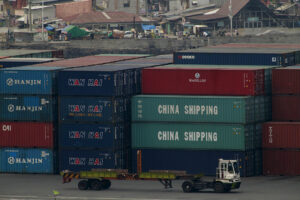PHL urged to pursue critical mineral deal with United States

By Justine Irish D. Tabile, Reporter
THE PHILIPPINES should pursue a sectoral agreement with the United States with a focus on critical minerals, even as it hopes to forge a free trade agreement (FTA) under President Donald J. Trump’s administration.
“We do have a good chance of being able to pull that (FTA), but I think it would have to be sectoral. It can’t be the entire free trade agreement,” said Jose Manuel D. Romualdez, Philippine ambassador to the US, at the US-Philippines Society press briefing on Tuesday.
“We’ve had some discussions during the first Trump administration on how we would proceed on the FTA, but that obviously was abbreviated, and so we have a chance now to renew that,” he added.
Mr. Romualdez said the idea was floated during his talks with former US Commerce Secretary Wilbur L. Ross, Jr.
“His advice to me was for us to pursue a sectoral type of FTA, like for instance in minerals, which we can offer the US, and then on the aspect of other areas where we can also be helpful, like semiconductors,” he said.
“While the US is trying to bring all of that back into the US, we are one of seven countries that have been identified as trusted allies of the US. So, we can be a recipient of some of that semiconductor industry that’s being moved out of China,” he added.
Asked why critical minerals should be a priority, Mr. Romualdez said this is an area where the Philippines and the US could mutually benefit from.
“It’s one of our natural resources, and part of our wealth. And we could get better prices for nickel, for instance, if we were able to process it here,” he said.
More than 90% of Philippine nickel exports go to China, Mr. Romualdez said.
“They get the entire thing, and they even dictate prices. So, we want to change that. We’ve been pursuing the critical minerals agreement with the US, even during the Biden administration, and we will pursue it even more vigorously this time,” he added.
Earlier this year, the Philippine Department of Trade and Industry said the country would double efforts to secure an FTA with the US.
“The Philippines needs the FTA with the US, and equally important is that the partners within the region, like Japan and South Korea, need us to have an FTA with the US,” said Trade Undersecretary Ceferino S. Rodolfo.
“This is so they can secure a non-China supply chain for certain critical industries, including our minerals for batteries,” he added.
The Philippines is the biggest exporter of nickel ore concentrate, accounting for more than one-fourth of the global supply. Of the country’s total nickel ore concentrate exports, over 98% go to China, while 1% go to Japan.
Rene D. Almendras, a member of US-Philippines Society, said that the Philippines should push for a sectoral agreement focusing on critical minerals as it will benefit provincial areas.
“A revitalized mining industry will benefit rural and provincial areas that have been neglected in the past. So, if we’re able to revive that industry, then the benefits will be very, very good in the areas where we most need it,” he said.
“The geographic location of those mines and hopefully those processing facilities will spur development in those areas where it is badly needed. And the Marcos administration is doing a really good job trying to decentralize the economy,” he added.
However, Mr. Almendras said the Philippines would have to first address potential investors’ concerns over power supply.
Aside from a sectoral FTA, Mr. Romualdez said there is a good chance that the US Generalized System of Preferences (GSP) would be reauthorized by the US Congress.
“[There is] a very good chance, actually. There are so many other countries who are working to get that GSP… In the US Congress, while they all agree that the GSP should be given to the Philippines, there’s some issues that each senator or a congressman would like to insert or they would like a bargaining chip,” he said.
“But we’re confident that we will be able to pass it through within this coming Congress.”
The Philippines was a beneficiary of the US GSP, which eliminated duties on about 5,000 or 47% of the total US tariff lines.
However, the Philippines’ eligibility for the US GSP benefits expired on Dec. 31, 2020, which meant Philippine exports to the US that were previously duty-free under the preferential scheme are now subject to most-favored-nation tariffs.
While active, the Philippines was the fifth-largest beneficiary of the US GSP with about $1.6 billion in duty-free exports in 2020. This made up 10% of the total US GSP imports, which amounted to $16 billion.
Earlier this month, the Philippine Exporters Confederation, Inc. lobbied for the reauthorization of the US GSP, saying that it could increase exports, especially of hard goods, by 5-10% this year.




